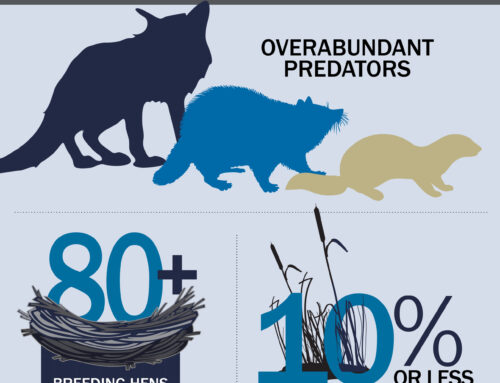Helping Eiders

Researchers are deploying structures to raise nest success in Nova Scotia
By Paul Wait
Common eiders nesting on offshore islands of Nova Scotia are declining, and researchers are seeking ways to help the largest of North American ducks breed more successfully.
“Some islands that used to have more than 100 eiders nesting on them now have zero eiders nesting on them,” said Dr. Mark Mallory, a sea bird researcher and biologist at Acadia University in Wolfville, Nova Scotia. “We’re trying to see if we can help eider populations recover.”
While habitat loss and natural changes to islands are certainly part of the challenge for eiders, Mallory points to increased predation during nesting season as the primary reason for the decline.

Black-backed gulls are a primary egg predator of common eiders. They perch in wait, hoping the hen will leave her nest unattended. Note the two types of artificial nesting structures side by side.
“Predation is the problem,” he said. “There are more avian predators now, and more mammalian predators because of reduced trapping efforts because pelts aren’t worth much money.”
In particular, Mallory points to four major predators impacting common eiders: black-backed gulls, bald eagles, mink and otters. The recovery of bald eagle populations has made nesting more perilous for eiders, while mink and otters are now residing on eider nesting islands where in the past they were infrequent visitors or not present at all. One study conducted by the Mallory Lab at Acadia University calculated survival in adult female eiders at the Eastern Shore Islands Wildlife Management Area to be 83 percent, which was markedly lower than the 92 percent survival rates for male eiders there.

Researchers deployed pilot project nesting structures designed to improve nest success on Nova Scotia islands.
Deploying Nest Structures
Eiders naturally nest under driftwood and trees on coastal islands. Changes in bird and animal communities using those islands have made them less suited for eiders. For example, Mallory said that increasing cormorant populations have caused some islands to lose all tree cover. The cormorants colonize an island, and the acidity of their droppings kills the trees and plants. For a few years, the dead wood provides good cover, but once that wood rots or washes away, the island no longer provides eider nesting habitat.
So, eiders need some help.
Mallory is working with Glen Parsons of the Nova Scotia Department of Natural Resources on a pilot project to test new wooden nesting structures specifically built for eiders.
Mallory, Parsons and Acadia students placed 50 wooden A-frame structures on known eider nesting islands. The structures, which are designed with escape openings on both ends, seem to be an improvement over blue barrels cut in half that have been deployed in the past.
“Eiders are tough birds and can defend themselves well against avian predators, but if a mink or an otter corners them in a blue barrel, it’s not good for the eider,” Mallory explained.
In addition, the A-frame design provides more ventilation than a blue barrel.
“When a Nova Scotia research team was doing some health work on eiders using barrel nest structures, the veterinarian said the ducks seemed a bit dehydrated,” Mallory said. “When you put eiders in enclosed nest structures that protect them from predators, our guess is they overheat and they don’t have access to fresh water.”
The slats in the roof allow heat to escape, and rain water can also reach the ducks. Nesting hen eiders spend most their time sitting on eggs, so they will drink rainwater and dew off their own backs, according to Mallory.

The recovery of bald eagles has increased eider mortality on Nova Scotia’s coastal islands.
Another positive of the wooden nests is that they will weather and blend in with the driftwood and brush, whereas blue barrels do not.
Broadening the Effort
Following encouraging results during the pilot project, the Mallory Lab and Nova Scotia DNR are moving ahead with research to compare nest success of natural cover nests, blue barrels and the A-frame nests next spring. The study will also look at which nesting locations eiders prefer, as well as if the presence of nest structures increases the numbers of eiders using the islands.
Mallory is seeking a graduate student to work on the next phase.
Delta Waterfowl contributed $5,000 to the project in 2018, and going forward, four Nova Scotia Delta chapters — Southwest Nova, Truro, Richmond County and Strait Shore — have pledged to contribute 10 percent of their Waterfowl Heritage Funds raised at events to the eider research.
If eiders take to the new nest structures and they work well to deter predation, Mallory hopes their use will spread throughout the eider’s nesting range.
“There’s been a lot of interest from local conservation groups,” Mallory said. “Eiders on the East Coast have a cultural cachet. It’s a really cool story.”
Paul Wait is editor and publisher of Delta Waterfowl magazine.






Leave A Comment